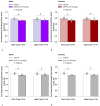The Chimeric Peptide (GEP44) Reduces Body Weight and Both Energy Intake and Energy Expenditure in Diet-Induced Obese Rats
- PMID: 40243702
- PMCID: PMC11989200
- DOI: 10.3390/ijms26073032
The Chimeric Peptide (GEP44) Reduces Body Weight and Both Energy Intake and Energy Expenditure in Diet-Induced Obese Rats
Abstract
We recently reported that a chimeric peptide (GEP44) targeting the glucagon-like peptide-1 receptor (GLP-1R) and neuropeptide Y1- and Y2- receptors decreased body weight (BW), energy intake, and core temperature in diet-induced obese (DIO) male and female mice. In the current study, we tested the hypothesis that the strong reduction in body weight in response to GEP44 is partially related to the stimulation of energy expenditure (EE). To test this, rats were maintained on a high fat diet (HFD) for at least 4 months to elicit DIO prior to undergoing a sequential 2-day vehicle period, 2-day GEP44 (50 nmol/kg) period, and a minimum 2-day washout period, and detailed measures of energy homeostasis. GEP44 (50 nmol/kg) reduced EE (indirect calorimetry), respiratory exchange ratio (RER), core temperature, activity, energy intake, and BW in male and female rats. As in our previous study in mice, GEP44 reduced BW in male and female HFD-fed rats by 3.8 ± 0.2% and 2.3 ± 0.4%, respectively. These effects appear to be mediated by increased lipid oxidation and reductions in energy intake as GEP44 reduced RER and cumulative energy intake in male and female HFD-fed rats. The strong reduction in body weight in response to GEP44 is related to a robust reduction in energy intake, but not to the stimulation of EE. The paradoxical finding that GEP44 reduced EE might be secondary to a reduction in diet-induced thermogenesis or might indicate an important mechanism to limit the overall efficacy of GEP44 to prevent further weight loss.
Keywords: GLP-1; PYY; iBAT; iWAT; multi-agonist; obesity.
Conflict of interest statement
The authors declare no conflict of interest.
Figures





Update of
-
The Chimeric Peptide (GEP44) Reduces Body Weight and Both Energy Intake and Energy Expenditure in Diet-Induced Obese Rats.bioRxiv [Preprint]. 2025 Feb 22:2025.01.06.631534. doi: 10.1101/2025.01.06.631534. bioRxiv. 2025. Update in: Int J Mol Sci. 2025 Mar 26;26(7):3032. doi: 10.3390/ijms26073032. PMID: 39829931 Free PMC article. Updated. Preprint.
Similar articles
-
The Chimeric Peptide (GEP44) Reduces Body Weight and Both Energy Intake and Energy Expenditure in Diet-Induced Obese Rats.bioRxiv [Preprint]. 2025 Feb 22:2025.01.06.631534. doi: 10.1101/2025.01.06.631534. bioRxiv. 2025. Update in: Int J Mol Sci. 2025 Mar 26;26(7):3032. doi: 10.3390/ijms26073032. PMID: 39829931 Free PMC article. Updated. Preprint.
-
The novel chimeric multi-agonist peptide (GEP44) reduces energy intake and body weight in male and female diet-induced obese mice in a glucagon-like peptide-1 receptor-dependent manner.Front Endocrinol (Lausanne). 2024 Jul 22;15:1432928. doi: 10.3389/fendo.2024.1432928. eCollection 2024. Front Endocrinol (Lausanne). 2024. PMID: 39104812 Free PMC article.
-
The Novel Chimeric Multi-Agonist Peptide (GEP44) Reduces Energy Intake and Body Weight in Male and Female Diet-Induced Obese Mice in a Glucagon-Like Peptide-1 Receptor-Dependent Manner.bioRxiv [Preprint]. 2024 May 21:2024.05.17.594690. doi: 10.1101/2024.05.17.594690. bioRxiv. 2024. Update in: Front Endocrinol (Lausanne). 2024 Jul 22;15:1432928. doi: 10.3389/fendo.2024.1432928. PMID: 38826286 Free PMC article. Updated. Preprint.
-
Proximate causes for diet-induced obesity in laboratory mice: a case study.Eur J Clin Nutr. 2017 Mar;71(3):306-317. doi: 10.1038/ejcn.2016.243. Epub 2017 Feb 1. Eur J Clin Nutr. 2017. PMID: 28145422 Review.
-
Analysis of energy expenditure in diet-induced obese rats.Front Biosci (Landmark Ed). 2014 Jun 1;19(6):967-85. doi: 10.2741/4261. Front Biosci (Landmark Ed). 2014. PMID: 24896330 Free PMC article. Review.
References
MeSH terms
Substances
Grants and funding
LinkOut - more resources
Full Text Sources
Medical
Research Materials

